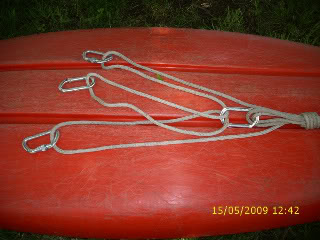Good anchors
Good anchors should be able to hold several times the expected load. Where possible, tie the anchor as close to the load bearing point as possible (like the pulley or belayer). Try to keep the anchor in line with the load you are pulling. Avoid having the anchor load shift as this can weaken an anchoring system. Haul lines are typically integrated into an anchoring system. It doesn't hurt to set up a second belay line to take stress off the haul line for resetting Z drags or as a tag line for when the pinned boat is freed. As stated before, test your anchors under some load and always use a spotter.
Places team at higher risk; consider what happens if the anchor fails
If a decent tree trunk is available, setting an anchor is a breeze. Life isn't always fair though. Often trees are not close enough and we need to make due with boulders or large rocks. Chocking may be the only way to set an anchor. All anchors should be tested under a bit of load before they can be trusted. With marginal anchors, you may need to set more than one to spread the load. There are several ways that anchoring systems can fail. That chock or large rock may shift under heavy loads. Improperly tied knots can fail. Older rope may stretch and break. Friction weakens rope rather quickly, especially polypropylene which has a very low melting point. A snapped rope acts like a snapped wire and can lacerate a person caught in its path. Pulleys or carabineers can become dangerous projectiles. Plan ahead, use dampers and brakes. Wear your protective gear like helmets and PFDs. Consider adding a direction change pulley or carabineer to take you out of the line of fire. Always have someone not pulling act as a spotter for any signs of failure in the system.
Here is a short video from our annual "Fun With Ropes" Winter class where we intentionally force a Z Drag to fail. Listen to the final pull and the very loud snap as our hardware hits the tree. In this class, we only had a few persons pulling and engineered an intentional break point. Under real conditions, that projectile would have been far more serious. This demonstration clearly shows why safety precautions are very important.
Foundation for many advanced skills
The foundation of a house holds the entire weight of the building. If the foundation falters, the house caves in with disastrous results. A similar concept holds when using a mechanical advantage system for unpinning a boat. That tree trunk with webbing wrapped around it is your anchor on a Z Drag. Both your team and the swamped boat are pulling against that anchor to free the boat. If you wrap webbing several times before adding the pulley, all is well. If you use a simple girth hitch and place the knot under stress, chances are pretty high that it will fail. If you are in the line of fire for that pulley, you will get injured.
An anchor belay is real handy for light weight paddlers setting safety. Climbers use this technique pretty frequently. Stabilization lines often make use of anchors as well. All high lines require anchoring. Good anchors ensure the end of the rope will not move under load and are often used to free people to work on other tasks (like pulling on the other end of the line).
Anchors
 Identifying solid anchor points in many river locations is not as easy as it may seem. You can't always count on conveniently placed trees. This section will expand your imagination for alternate anchoring mechanisms and how useful webbing becomes.
Identifying solid anchor points in many river locations is not as easy as it may seem. You can't always count on conveniently placed trees. This section will expand your imagination for alternate anchoring mechanisms and how useful webbing becomes.
Anchoring is critical for a number of rope based rescues. People can hold a taught rope for only so long before they tire. Decent footing isn't always available where you need it. When you free a canoe full of water that weighs several tons, you need an anchor for that tag line to bring it on shore. These are just a few of the many uses for anchors.
Page 3 of 3
